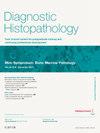Mature B-cell leukemias/lymphomas in the bone marrow: beyond chronic lymphocytic leukemia and mantle cell lymphoma
引用次数: 0
Abstract
Differentiating between reactive B-cell infiltrates, clonal non-lymphomatous B-cell proliferations and small B-cell lymphomas in the bone marrow (BM) can be a challenging task, especially in consideration of the high number of potential differential diagnoses, the rather subtle morphological differences and the often non-specific phenotypes. It requires a high degree of integration of clinical, laboratory, morphological, immunophenotypical and genetic information to define a definitive diagnosis. Besides the well-defined lymphomas involving the bone marrow, like follicular lymphoma (FL) and lymphoplasmacytic lymphoma (LPL), diagnostic clues to distinguish more difficult entities, such as splenic marginal zone lymphoma (SMZL), splenic diffuse red pulp B-cell lymphoma (SDRPBL) and splenic small B-cell lymphoma with prominent nucleoli/hairy cell leukemia variant (SBCLPN/HCLV) are discussed; also, the BM patterns of non-lymphomatous clonal B-cell lymphoproliferations, such as monoclonal B-cell lymphocytosis (MBL) and primary cold agglutinin disease (PCAD) are described. This review is intended to guide a diagnostically-oriented pathologist through the conundrum of possible entities presenting in the bone marrow. A practical approach is presented, which can be implemented in daily routine. We will also highlight the limitations of the bone marrow biopsy in establishing a primary diagnosis of lymphoma, especially in absence of the ancillary information.
骨髓成熟b细胞白血病/淋巴瘤:除慢性淋巴细胞白血病和套细胞淋巴瘤外
区分骨髓中的反应性b细胞浸润、克隆性非淋巴瘤b细胞增殖和小b细胞淋巴瘤(BM)可能是一项具有挑战性的任务,特别是考虑到大量潜在的鉴别诊断、相当微妙的形态学差异和通常的非特异性表型。它需要高度整合临床,实验室,形态学,免疫表型和遗传信息来确定明确的诊断。除滤泡性淋巴瘤(滤泡性淋巴瘤)、淋巴浆细胞性淋巴瘤(淋巴浆细胞性淋巴瘤)等明确的累及骨髓的淋巴瘤外,本文还讨论了脾边缘区淋巴瘤(SMZL)、脾弥漫性红髓b细胞淋巴瘤(SDRPBL)、脾小b细胞淋巴瘤伴核仁/毛细胞白血病变异型(SBCLPN/HCLV)等较难区分的诊断线索;此外,本文还描述了非淋巴瘤性克隆b细胞淋巴细胞增生的BM模式,如单克隆b细胞淋巴细胞增多症(MBL)和原发性冷凝集素病(PCAD)。本综述旨在指导诊断导向的病理学家通过可能的实体呈现在骨髓难题。提出了一种实用的方法,可以在日常工作中实现。我们还将强调骨髓活检在淋巴瘤初步诊断中的局限性,特别是在缺乏辅助信息的情况下。
本文章由计算机程序翻译,如有差异,请以英文原文为准。
求助全文
约1分钟内获得全文
求助全文
来源期刊

Diagnostic Histopathology
Medicine-Pathology and Forensic Medicine
CiteScore
1.30
自引率
0.00%
发文量
64
期刊介绍:
This monthly review journal aims to provide the practising diagnostic pathologist and trainee pathologist with up-to-date reviews on histopathology and cytology and related technical advances. Each issue contains invited articles on a variety of topics from experts in the field and includes a mini-symposium exploring one subject in greater depth. Articles consist of system-based, disease-based reviews and advances in technology. They update the readers on day-to-day diagnostic work and keep them informed of important new developments. An additional feature is the short section devoted to hypotheses; these have been refereed. There is also a correspondence section.
 求助内容:
求助内容: 应助结果提醒方式:
应助结果提醒方式:


